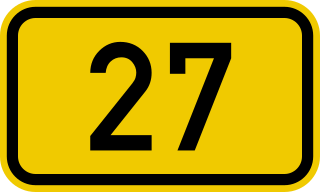
The international E-road network is a numbering system for roads in Europe developed by the United Nations Economic Commission for Europe (UNECE). The network is numbered from E1 up and its roads cross national borders. It also reaches Central Asian countries like Kyrgyzstan, since they are members of the UNECE.
Südwestrundfunk is a regional public broadcasting corporation serving the southwest of Germany, specifically the federal states of Baden-Württemberg and Rhineland-Palatinate. The corporation has main offices in three cities: Stuttgart, Baden-Baden and Mainz, with the director's office being in Stuttgart. It is a part of the ARD consortium. It broadcasts on two television channels and six radio channels, with its main television and radio office in Baden-Baden and regional offices in Stuttgart and Mainz. It is the second largest broadcasting organization in Germany. SWR, with a coverage of 55,600 km2, and an audience reach estimated to be 14.7 million. SWR employs 3,700 people in its various offices and facilities.

Donaueschingen is a German town in the Black Forest in the southwest of the federal state of Baden-Württemberg in the Schwarzwald-Baar Kreis. It stands near the confluence of the two sources of the river Danube.

The Höllentalbahn is a railway line that partially runs through the Höllental valley in the Black Forest of Germany. The line connects Freiburg im Breisgau with Donaueschingen, a distance of 74.7 km (46.4 mi).

Offenburg is a city located in the state of Baden-Württemberg, Germany. With nearly 60,000 inhabitants (2019), it is the largest city and the administrative capital of the Ortenaukreis.

The Kinzig is a river in southwestern Germany, a right tributary of the Rhine.

The Baden Black Forest Railway is a twin-track, electrified railway line in Baden-Württemberg, Germany, running in a NW-SE direction to link Offenburg on the Rhine Valley Railway (Rheintalbahn) with Singen on the High Rhine Railway (Hochrheinbahn). Passing directly across the Black Forest, through spectacular scenery, the route is 150 km long, ascends 650 metres from lowest to highest elevation, and passes through 39 tunnels and over 2 viaducts. It is still the only true mountain railway in Germany to be built with two tracks, and is the most important railway line in the Black Forest. It was built between 1863 and 1873, utilizing plans drawn up by Robert Gerwig.
The Amateurliga Südbaden was the highest football league in the region of the Südbaden FA and the third tier of the German football league system from its inception in 1945 to the formation of the Oberliga Baden-Württemberg and the Verbandsliga Südbaden below it in 1978.

European route E35 is a European route that runs from Amsterdam, Netherlands, in northwestern Europe, to Rome, Italy in the south of the continent. The road heads through Germany and Switzerland before reaching Italy.

Bundesstraße 27 or B27 is a German federal road. It connects Blankenburg am Harz with Rafz in Switzerland.

European route E33 is a series of roads in Italy, part of the United Nations International E-road network.

The Baden main line is a German railway line that was built between 1840 and 1863. It runs through Baden, from Mannheim via Heidelberg, Karlsruhe, Offenburg, Freiburg, Basle, Waldshut, Schaffhausen and Singen to Constance (Konstanz). The Baden Mainline is 412.7 kilometres long, making it the longest route in the Deutsche Bahn network and also the oldest in southwest Germany. The section between Mannheim and Basle is the most important northern approach to the Swiss Alpine passes, whilst the section between Basle and Constance is only of regional significance. The stretch from Karlsruhe to Basle is also known as the Rhine Valley Railway (Rheintalbahn) and the Basle–Constance section as the High Rhine Railway (Hochrheinstrecke).

The Ulm–Sigmaringen railway is a 92.670-kilometre-long railway in Baden-Württemberg in south-western Germany, which is largely single-tracked and for the most part not electrified. It runs from Ulm via Blaubeuren and Riedlingen to Sigmaringen mostly in the valley of the Danube. The line is part of the once important long-distance connection from Munich to Freiburg im Breisgau.

The Mannheim–Karlsruhe–Basel railway is a double-track electrified mainline railway in the German state of Baden-Württemberg. It runs from Mannheim via Heidelberg, Bruchsal, Karlsruhe, Rastatt, Baden-Baden, Offenburg and Freiburg to Basel, Switzerland. It is also known as the Rhine Valley Railway or the Upper Rhine Railway (Oberrheinbahn).

Offenburg Hauptbahnhof is a railway station in Baden-Württemberg and has seven tracks on four platforms. Offenburg used to be a railway town and the station was of major economic importance to it. In recent years the maintenance facilities and much of the rail freight yards have been closed. The station is very centrally located within the city and is easily accessible by 18 different bus routes from the central bus station, 50 metres from the railway station.

The University of Applied Sciences Offenburg, with its head office in Offenburg and a branch in Gengenbach, is a German university owned by the state of Baden-Württemberg. It is one of the most important educational institutions in the southern Upper Rhine area. Currently, about 4,090 students are enrolled.

E 532 is a European B class road in connecting the cities Memmingen, Germany – Telfs, Austria.

The Bundesstraße 31 (B 31) is a federal highway or Bundesstraße running from east to west in South Germany. It runs from Breisach on the border with France to the Sigmarszell junction on the Bundesautobahn 96 (A 96) near Lindau. Between the transition of the Bundesautobahn 98 (A 98) to the B 31 near the Stockach-Ost exit and Sigmarszell junction on the A 96 it is part of the E 54 from Paris to Munich.

The Karlsruhe–Basel high-speed railway is a new line being built on the route of the Mannheim–Karlsruhe–Basel railway. As a result of the project, the railway through the Rhine Valley is being upgraded to four continuous tracks and its operational efficiency will be increased as a result of the segregation of the various transport flows. The travel time for passenger services between Karlsruhe and Basel is to be shortened by 31 minutes. The project forms part of the Rotterdam–Genoa corridor and part of it is also part of the Main line for Europe. In September 2010, it was forecast to be completed in 2020.

The Ringzug, also called the 3er-Ringzug is a passenger transport network in the districts of Tuttlingen, Rottweil and Schwarzwald-Baar in southern Baden-Württemberg, Germany. The Ringzug went into regular operations on 31 August 2003 and has operated in its current form since 12 December 2004. The concept of the Ringzug is the operation of a clockface timetable, coordinated with a variety of other buses and train services, over an S-Bahn-like network in a rural environment. In March 2006, the passenger association Pro Bahn described the Ringzug as an exemplary public transport system at its 2006 passenger transport awards. The Ringzug has aroused interest beyond the region and can point to steadily rising passenger numbers and declining deficits.



















